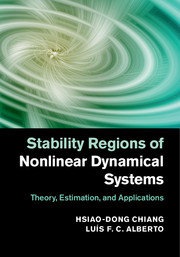Refine search
Actions for selected content:
1550 results in Control systems and optimization
List of Figures
-
- Book:
- Optimization in Chemical Engineering
- Published online:
- 05 February 2016
- Print publication:
- 11 March 2016, pp xiii-xvi
-
- Chapter
- Export citation
Multiple Choice Questions – 2
-
- Book:
- Optimization in Chemical Engineering
- Published online:
- 05 February 2016
- Print publication:
- 11 March 2016, pp 349-354
-
- Chapter
- Export citation
Frontmatter
-
- Book:
- Optimization in Chemical Engineering
- Published online:
- 05 February 2016
- Print publication:
- 11 March 2016, pp i-iv
-
- Chapter
- Export citation
Multiple Choice Questions – 1
-
- Book:
- Optimization in Chemical Engineering
- Published online:
- 05 February 2016
- Print publication:
- 11 March 2016, pp 343-348
-
- Chapter
- Export citation
Dedication
-
- Book:
- Optimization in Chemical Engineering
- Published online:
- 05 February 2016
- Print publication:
- 11 March 2016, pp v-vi
-
- Chapter
- Export citation
Contents
-
- Book:
- Optimization in Chemical Engineering
- Published online:
- 05 February 2016
- Print publication:
- 11 March 2016, pp vii-xii
-
- Chapter
- Export citation
6 - Multivariable Optimization with Constraints
-
- Book:
- Optimization in Chemical Engineering
- Published online:
- 05 February 2016
- Print publication:
- 11 March 2016, pp 119-156
-
- Chapter
- Export citation
4 - Trust-Region Methods
-
- Book:
- Optimization in Chemical Engineering
- Published online:
- 05 February 2016
- Print publication:
- 11 March 2016, pp 74-85
-
- Chapter
- Export citation
10 - Optimization of Various Chemical and Biochemical Processes
-
- Book:
- Optimization in Chemical Engineering
- Published online:
- 05 February 2016
- Print publication:
- 11 March 2016, pp 258-283
-
- Chapter
- Export citation
8 - Some Advanced Topics on Optimization
-
- Book:
- Optimization in Chemical Engineering
- Published online:
- 05 February 2016
- Print publication:
- 11 March 2016, pp 180-221
-
- Chapter
- Export citation
Index
-
- Book:
- Optimization in Chemical Engineering
- Published online:
- 05 February 2016
- Print publication:
- 11 March 2016, pp 359-362
-
- Chapter
- Export citation
2 - Formulation of Optimization Problems in Chemical and Biochemical Engineering
-
- Book:
- Optimization in Chemical Engineering
- Published online:
- 05 February 2016
- Print publication:
- 11 March 2016, pp 12-39
-
- Chapter
- Export citation
1 - A Brief Discussion on Optimization
-
- Book:
- Optimization in Chemical Engineering
- Published online:
- 05 February 2016
- Print publication:
- 11 March 2016, pp 1-11
-
- Chapter
- Export citation
5 - Optimization of Unconstrained Multivariable Functions
-
- Book:
- Optimization in Chemical Engineering
- Published online:
- 05 February 2016
- Print publication:
- 11 March 2016, pp 86-118
-
- Chapter
- Export citation
Multiple Choice Questions – 3
-
- Book:
- Optimization in Chemical Engineering
- Published online:
- 05 February 2016
- Print publication:
- 11 March 2016, pp 355-358
-
- Chapter
- Export citation
9 - Nontraditional Optimization
-
- Book:
- Optimization in Chemical Engineering
- Published online:
- 05 February 2016
- Print publication:
- 11 March 2016, pp 222-257
-
- Chapter
- Export citation
3 - Single Variable Unconstrained Optimization Methods
-
- Book:
- Optimization in Chemical Engineering
- Published online:
- 05 February 2016
- Print publication:
- 11 March 2016, pp 40-73
-
- Chapter
- Export citation

Optimization in Chemical Engineering
-
- Published online:
- 05 February 2016
- Print publication:
- 11 March 2016

Stability Regions of Nonlinear Dynamical Systems
- Theory, Estimation, and Applications
-
- Published online:
- 05 September 2015
- Print publication:
- 13 August 2015
Preface
-
- Book:
- Stability Regions of Nonlinear Dynamical Systems
- Published online:
- 05 September 2015
- Print publication:
- 13 August 2015, pp vii-viii
-
- Chapter
- Export citation
